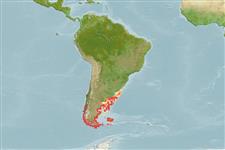Common names from other countries
Environment: milieu / climate zone / depth range / distribution range
Οικολογία
Θαλασσινό(ά) βενθοπελαγικό; εύρος βάθους 0 - 250 m (Ref. 127764). Temperate; 32°S - 57°S, 76°W - 53°W
Southeast Pacific and Southwest Atlantic: Valparaíso, Chile and Patagonian region of Argentina to Tierra del Fuego.
Μέγεθος / Βάρος / Age
Maturity: Lm ? range ? - ? cm
Max length : 90.0 cm TL (female); μεγ. δημοσιευμένο βάρος: 0.00 g
Ραχιαίες άκανθες (συνολικά) : 7 - 8; Μαλακές ραχιαίες ακτίνες (συνολικά) : 23 - 27; Εδρικές άκανθες: 0; Μαλακές εδρικές ακτίνες: 0. Caudal fin emarginate. Body blue brown dorsally and silvery yellow ventrally. First and second dorsal fins grayish, caudal fin brownish, their distal parts yellowish. Anal fin pale brown (Ref. 27363).
Life cycle and mating behavior
Maturities | Αναπαραγωγή | Spawnings | Egg(s) | Fecundities | Προνύμφες
Corporacion de Fomento de la Produccion (Chile), 1980. Catálogo de recursos pesqueros Chile. Instituto de Fomento Pesquero, Gerencia de Desarollo, CORFO, Santiago, Chile. (Ref. 5964)
IUCN Red List Status (Ref. 130435)
CITES (Ref. 128078)
Not Evaluated
Threat to humans
Harmless
Human uses
αλιεία: περιορισμένης εμπορικότητας
Εργαλεία
Special reports
Download XML
Διαδικτυακές πηγές
Estimates based on models
Preferred temperature (Ref.
115969): 7 - 16.1, mean 10.7 (based on 172 cells).
Phylogenetic diversity index (Ref.
82804): PD
50 = 1.5000 [Uniqueness, from 0.5 = low to 2.0 = high].
Bayesian length-weight: a=0.00977 (0.00428 - 0.02232), b=3.06 (2.85 - 3.27), in cm Total Length, based on LWR estimates for this (Sub)family-body shape (Ref.
93245).
Τροφικό Επίπεδο (Ref.
69278): 3.5 ±0.41 se; based on food items.
Ελαστικότητα (Ref.
120179): Μεσαίο(α), ελάχιστος χρόνος για διπλασιασμό πληθυσμού 1,4 - 4,4 έτη (Assuming tm <4).
Fishing Vulnerability (Ref.
59153): High vulnerability (61 of 100).
Climate Vulnerability (Ref.
125649): Very high vulnerability (100 of 100).
